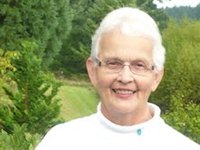

I was 58 years old in 1999 when I was first diagnosed with ovarian cancer. My life was full with community and family activities as well as hiking, skiing, traveling & gardening. I worked at a local hospice and also helped in the operation of the berry farm my husband and I own.
As I look back, my first symptom was a change in my bowel habits. I also noticed that my clothes were feeling a little tight around the mid section, but with a busy schedule I put both symptoms off to not eating regularly and not drinking enough water. I couldn’t imagine having anything serious while feeling as well as I did.
A few weeks after experiencing these initial symptoms, I suddenly could not void. That got my attention and also my primary care physician’s. After hours of tests and a pelvic rectal exam, my doctor ordered a lung X-ray which showed fluid around my lungs.
With that result, I was admitted to the hospital for diagnostic purposes. Multiple tests were performed over a three-day period. After the test results came back, a surgeon and my primary care doctor told me it was likely I had ovarian cancer and they wanted to do surgery ASAP. They both assured me that ovarian cancer was treatable and no longer the “death sentence” it had been in the recent past.
Following the standard ovarian cancer debulking surgery, my doctor reported to my family that small tumors were found throughout my abdominal cavity. At that time, I wasn’t ready to learn what stage cancer I had.
Weeks later, when I was ready, I was told I had stage IV ovarian cancer.
Three days following my surgery, I met with an oncologist who assured me that late stage ovarian cancer is treatable. Hearing this again was very reassuring. He explained the protocol for Taxol/ Carboplatin and said we would start treatment three weeks following surgery.
I proceeded with six chemo treatments. My CA-125 blood test was 1,831 prior to surgery and dropped to 380 after surgery. After three of the six treatments it fell to 8 and stayed in the normal range where it stayed for four years.
Following my treatments, I began to gain energy and strength. Gradually, I resumed my activities. The support I received from family, friends, the medical staff and our larger community was something I will forever cherish. It was a real lesson to me in the variety of ways others are truly there for us. I often think of the year of my initial illness as one of the best of my life. I learned that the support and love I received then could actually help me overcome the fears and trepidation of a life-threatening illness.
In 2003, four years from my original diagnosis, my CA-125 rose from the normal range to 126. I had no symptoms at this time. My oncologist ordered a CAT and a PET scan. Both showed two spots that were likely tumors. Surgery was scheduled. The surgeon removed the tumors and reported that my abdominal cavity looked “pristine.” Because of my relatively long remission and good response from Taxol/Carboplatin, I was given the same six treatments I had had in 1999.
I have had no recurrence since 2003 and am here to say that there is life after ovarian cancer and after a recurrence. My port was finally removed three years ago and I now see my oncologist every 6 months for an exam and a CA-125 blood test. I try to remain cognizant each day of the gift of life. I am forever grateful to my family, friends and the medical staff who have been with me on this journey. I have met some of the most incredible women who share this diagnosis and they are an inspiration and support to me. And then there is the wonderful Ovarian Cancer Alliance of Oregon and SW Washington which provides invaluable information, support, and ways others can constructively contribute to the education and support of others.
Most of my friends like to ignore their birthdays as we all age. After my initial diagnosis I did not expect to have fourteen additional birthdays. I celebrate each one with amazement, with gratitude and with JOY!
